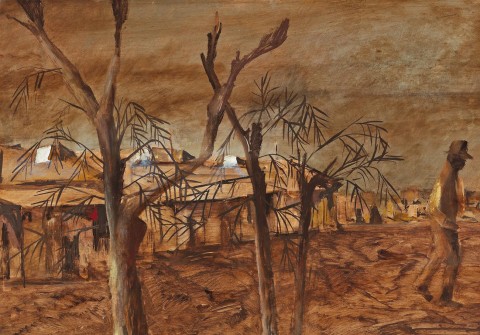DUST STORM OVER DARWIN, 1951
SIDNEY NOLAN
oil on composition board
75.0 x 106.0 cm
signed and dated lower right: NOLAN 51
signed and inscribed verso: AIR / NOLAN
Redfern Gallery, London
The Landau Collection, Sydney, acquired from the above in 1963
Sotheby’s, Melbourne, 25 August 1997, lot 244
Nevill Keating Pictures, London
Private collection, Melbourne
Summer Exhibition, Redfern Gallery, London, June 18 – September 1963, cat. 408
It was the success of Sidney Nolan’s exhibition of Queensland outback paintings in March 1949 that provided him with the financial means to travel to Central Australia later that year. With his new wife Cynthia and her daughter Jinx, Nolan left Sydney on June 22, staying overnight in Adelaide before a two-day train journey that would take them to Alice Springs, the starting point of a two-and-a-half-month trip. The experience transformed Nolan’s vision of the landscape: after seeing the country from the air he wrote in his diary that it was both ‘transparent and at the same time, impenetrable’1 and later, back in the studio and grappling with what he had seen, ‘Now that one knows it for an old, fragile & transparent land that is the way the paintings must tend’.2
The exhibition of the now celebrated Central Australian landscapes opened at David Jones’ Gallery, Sydney at the end of March 1950 and the positive response was immediate, with seventeen paintings being sold by the end of the show, including Dry Jungle, 1949, which was acquired by the National Art Gallery of New South Wales. The National Gallery of Victoria had purchased Central Australia, 1949 before the exhibition and later, the series achieved international recognition with a painting being purchased by the Tate, London in 1951 and another by the esteemed British art historian, Sir Kenneth Clark.3 James Gleeson recognised the significance of the exhibition, describing it in a contemporary review as ‘one of the most important events in the history of Australian painting … future art historians will date the birth of a predominantly Australian idiom from this exhibition … Nolan has been able to bring the vision of the poet and a respect for the objective facts of Nature into a single focus’.4
The desert landscape became the setting for many of the paintings Nolan produced during the following three years, from the brilliant reinterpretation of religious subjects such as Temptation of St Anthony, 1952 (National Gallery of Victoria, Melbourne), to images including Dust Storm Over Darwin, 1951, that describe the distinctive vernacular architecture, personalities and very physical experience of outback Australia. Here, a slightly ramshackle building, its doors and windows shaded by a long verandah, sits behind a trio of thin trees, their bare top branches a stark reflection of the tough natural environment. A lone figure at the right of the picture is painted in such a way that he almost merges with the landscape, a subtle reflection perhaps of Nolan’s realisation of the deep connection that exists between Indigenous Australians and the land. As he wrote to his friend and fellow artist, Albert Tucker, following the trip to Central Australia, ‘they show you that the country is a gentle dreaming one, the barrenness & harshness is all in our European eyes’.5 Apart from a few flashes of red and white paint, Nolan’s palette in this work is almost exclusively restricted to shades of ochre and brown. Despite this uniformity of tone, there is great variation in his application of the paint – from the lively sections of parallel brush marks that define the bare earth to the softness of the dust-filled sky, where the paint has been rubbed back to reveal glimpses of the blue expanse beyond – which gives the work a kind of swirling pictorial energy that echoes the experience of the event it depicts.
1. Sidney Nolan, diary notes, Alice Springs, 28 June 1949, Jinx Nolan Papers, quoted in Smith, G., Sidney Nolan: Desert and Drought, National Gallery of Victoria, Melbourne, 2003, p. 16
2. Sidney Nolan, diary notes, Sydney, 24 September 1949, Jinx Nolan Papers, quoted in ibid., p. 19
3. For more detail about sales from this exhibition see Smith, ibid., p. 25 and exhibition checklist, pp. 145 – 155
4. Gleeson, J., ‘Landscapes triumph for Aust. Artist’, Sun, Sydney, 31 March 1950, p. 19
5. Sidney Nolan to Albert Tucker, Sydney, 26 January 1950, Albert Tucker Papers, La Trobe Collection, State Library of Victoria, quoted in Smith, op. cit., p. 12
KIRSTY GRANT
